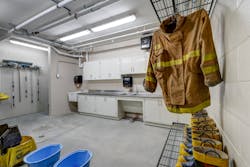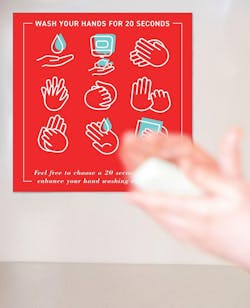Managing Contamination Through Affordable Best Practices
Management of carcinogens and other contaminants has become an increasingly important topic in the fire service. Additionally, the COVID pandemic raised awareness of biological contaminants and forced great deal of departments to adapt, frequently without the time or money to incorporate permanent features. This often led to simple and creative ways to think about management and mitigation of infection risks, many of which are applicable to other forms of contamination.
Clearly, when designing a new fire station, the building can be planned, and elements can be incorporated to inherently address contaminants, so mitigating risks and decontamination are intuitive and natural. So, yes, incorporating best practices within station design itself is an ideal way to address these concerns. Renovate an existing facility? Obviously, that can be impractical, and incorporating features to mitigate or eliminate hazards after the fact can be costly.
Don’t fret. Numerous ways to easily and inexpensively manage contamination can remedy many woes.
Turnouts, hardware and clothing
Contaminated gear should be cleaned as soon as possible and not stored in the apparatus bay, even for short periods of time and particularly not out in the open. Simple plastic bags are an effective way of isolating contaminated gear until it can be cleaned properly, and an extra set of gear should be used until then.
Crews also should consider the types of equipment and materials that are used or stored in the bay and its support spaces.
Washers and dryers for laundering shop towels and the like shouldn’t be used for uniforms and linens and vice versa.
If ice makers are used for food or drink, they shouldn’t be placed in or directly adjacent to apparatus bays.
Similarly, consideration should be given to quartermaster supplies, the types of supplies and where they are located relative to possible contamination.
If relocating these appliances and supplies isn’t possible, consider installing a ventilation system that will keep positive pressure in that space to minimize contaminants from entering the space.
Hardware between transition zones should be easy to use. Levers and foot pulls reduce the need to use hands to open doors. Exit devices can be pushed open with the hip. To help to reduce contamination, creating a thorough cleaning schedule for the hardware will help to reduce transfer of harmful particulates.
Further, sanitation stations that have wipes, hand sanitizer and shoe/boot covers are also an effective, inexpensive way to ensure that members can clean when needed before entering the living areas.
When entering the living areas of the station, personnel should consider what they are wearing and whether that potentially brings contaminants with it. Transition vestibules can include walk-off mats or other means of preventing material from being tracked into the living areas. An effective strategy might be to incorporate disposable sticky mats, as often seen used at clean room entrances and interior construction zones, to remove particulates from the soles of shoes.
Another inexpensive strategy for reducing such transfer of material might be a simple footwear solution: including shoe racks at the entrance to living areas, where personnel can change into “house slippers”—simple clogs or slides only to be worn in the living areas of the station.
This strategy requires cooperation between firefighters and administration to develop a policy of only allowing clean footwear in clean areas of the station. If this isn’t practical to employ throughout the station, it should be considered particularly for sleep rooms and other “soft spaces” that are within the facility.
Furniture and carpeting
Finish materials that are used throughout the facility for various purposes should support proper cleaning through simple maintenance techniques.
Although softer materials, such as carpet and fabric upholstery, might provide warmth, comfort, and favorable acoustics in living and sleeping areas of the firehouse, those materials also are prone to absorbing contaminants. Furthermore, they are difficult to clean as well as maintain. Simple, durable materials that have smooth surfaces are far better suited to firehouse environment, and they can be supplemented with removable and washable coverings.Signage and cleaning products
Posting signage provides visual reminders of the contamination-mitigating features that are employed in stations. This is a simple way to clarify available strategies and creates a “no excuses” scenario for policies and procedures.
Purchasing products and equipment that assist with cleaning and decontamination of common living areas is another area worthy of research and consideration. During the COVID-19 pandemic, a great deal of information-gathering has been done on the effectiveness of commercially available cleaning products and equipment. Ultraviolet lighting, air purifiers and cleaning mist machines, among others, can be advantageous tools to complement normal cleaning products and procedures.
A joint effort
Complete elimination and management of contaminants in existing stations might be difficult to achieve or impractical. However, once potential sources and avenues of contamination are identified, chiefs, officers and firefighters, with input from fire station designers, can get creative in addressing these concerns.
The Luxury of New Construction and Station Renovation
Regardless of origin, the primary source and avenue of contaminants in any firehouse is through the apparatus bay. Even with the practice of “clean on scene,” contaminants still enter the firehouse as residual material, via off-gassing of equipment and gear and because gross decontamination on scene isn’t 100 percent effective.
When planning a new fire facility or a station renovation, consideration should be given to the types of spaces and their adjacencies, to plan the building with zones of clean and dirty, including transitions between those spaces.
Apparatus bays, workshops, decontamination areas, storage for turnout gear and fire equipment, building and grounds maintenance areas, and similar spaces should be isolated from the living, sleeping and administrative areas of the firehouse. The flow of personnel through the station also should be considered to avoid any possibilities of cross-contamination.
A formal decontamination/clean room should be integrated into new station construction and, if possible, station remodels. This space allows contaminated individuals to disrobe and store/clean contaminated clothing. The decontamination room should have a shower and a sealed cabinet for clean towels, robes and slippers, to allow an individual to be free of nearly all contaminants prior to entering the living area of the station. A single toilet room that’s located directly off of the bay allows personnel to avoid entering the living areas for restroom breaks.
Apparatus bays should incorporate a means of flushing out airborne contaminants, particularly to address engine exhaust and fumes from fuel, solvents and other materials. Direct capture systems (hose-based or vehicle-mounted) work well for exhaust provided that they are maintained and used appropriately. However, knowing that exhaust isn’t the only source of airborne contaminants, building-space filtration in addition to direct capture offer a more comprehensive solution. These systems flow fresh air through the apparatus bays, ideally bringing outdoor air in low at the occupied zones of the space and passing it up and out of the building, so any accumulated contaminants are pushed away from occupants and surfaces that are commonly in contact with occupants. (See "The Ins & Outs of Vehicle Exhaust Extrication Systems”.)
Despite the use of these systems and operable doors to “air out the space,” apparatus bays shouldn’t be used for purposes that compromise health and safety. True, training in an apparatus bay might be a good use of the space, but exercise equipment, let alone picnic tables and lounge furniture, have no place in the bay. Even with air changes within the bay, contaminants can accumulate on surfaces, which then are handled by personnel, which allows the contaminants to be ingested or absorbed through the skin.
Aside from contaminants from apparatus exhaust, turnout gear clearly represents one of the highest risks of contamination in the station. Proper cleaning and storage of turnout gear is vital. After gross decontamination on scene, gear still should be separated from personnel, equipment and other materials; it shouldn’t be transported inside of the cab of apparatus.
Understanding that contaminants typically enter a station through the bay, creating transition zones and barriers between the bay and the rest of the station is a highly effective strategy. The means to accomplish this are multifactored. A layered, strategy is most effective. Just as ideal cleaning procedures include multiple wash and rinse cycles, so, too, should management of contaminants employ a layered approach.
An obvious transition zone includes air locks and vestibules between apparatus bay and the rest of the station. To function as effective air locks, the vestibules should be sealed with perimeter door gaskets and sweeps. The HVAC system also should provide zones of decreasing positive pressure from the habitable portion of the building toward the bay, so clean air always pushes bad air out through the bay. This is particularly important within areas where members eat and sleep. Although building-space filtration can supplement this air pressure strategy, opening and closing of bay doors doesn’t guarantee the appropriate pressure differentials. Creating an air curtain with pressure differentials at the vestibule and the entrance to the station can be considered in combination with the HVAC system design.
Off-Site Decontamination
Occasionally, alternative sites, such as schools, fitness centers and hospitals, are used to assist with decontamination, particularly in the case of large incidents or for convenience. Although this process clearly minimizes contamination within the station, one must consider the risks that are passed on to those spaces and their occupants.
About the Author
Nestor Melnyk
Nestor Melnyk, who is a principal at MSA Design, is recognized for his work in a range of public safety facilities projects, including fire/EMS, 9-1-1 communications and maritime safety, many of which received local, state and national awards. His active involvement in these projects enables him to develop and maintain relationships with industry experts and allows him to keep up with best practices and trends. Melnyk has presented at state and national conferences, including FIERO and the Ohio Fire Chiefs’ Association. He is deeply involved in public service and is active in both advisory and leadership roles that revolve around accessibility, developmental disabilities and children’s healthcare issues.
Steve Kelly
Steve Kelly is the Fire & EMS Chief for Miami Township Fire & EMS in Clermont County, OH. He is a 26-year veteran of the fire service. Kelly serves as the Southwest District Director for the Ohio Fire Chiefs’ Association, as the secretary of the Clermont County Fire Chiefs’ Alliance and as a member of the International Association of Fire Chiefs’ Program Planning Committee. He is a founding member of the State of Ohio-Butler County Incident Management Team, where he serves as a public information officer and liaison. As a newly promoted fire chief in 2013, one of Kelly’s first tasks was to establish a new fire station in an area of the community that was expanding.
Ethan Klussman
Ethan Klussman is a 30-year veteran of the fire service. He started his career as a volunteer firefighter before getting hired in 1996 as a career firefighter/paramedic for the city of Kettering, OH. During his tenure in Kettering, Klussman worked his way up through the ranks to battalion chief before taking on his current role as fire chief in Liberty Township, OH. While at Kettering, he sat on the building design committee as the city replaced four of its fire stations. As he transitioned to being fire chief of Liberty Township, Klussman was tasked with overseeing a station relocation project.

